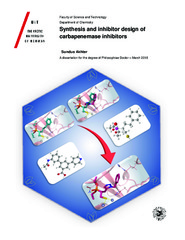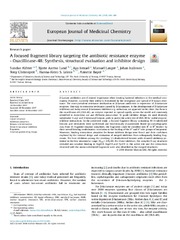| dc.contributor.advisor | Bayer, Annette | |
| dc.contributor.author | Akhter, Sundus | |
| dc.date.accessioned | 2018-06-25T07:42:41Z | |
| dc.date.available | 2018-06-25T07:42:41Z | |
| dc.date.issued | 2018-05-24 | |
| dc.description.abstract | The efficiency of bacteria in acquiring resistance for their survival ensures a never-ending war against resistance. The only tactic to curtail the resistance crisis is to keep pace with it, e.g. by continuous development of new antibiotics with activity against resistant bacteria or revival of existing agents by inhibiting the mechanisms of resistance. β-lactams are the largest and most widely used group of antibiotics. In response to β-lactams, bacteria can produce β-lactamases (BLs), enzymes that are responsible for hydrolysis and inactivation of β-lactam antibiotics. Currently, the main concern is BLs with activity against carbapenems, which is our most important group of β-lactams for the treatment of serious and life-threatening infections. In addition to inactivating carbapenems, these carbapenemases can hydrolyze almost all groups of β-lactams.
During our studies, we targeted several clinically relevant metallo-carbapenemases (VIM-2, NDM-1 and GIM-1) and a serine-carbapenemase (OXA-48) and aimed to develop potential inhibitors or fragments that can ultimately be used in combination therapy with antibiotics to prolong their lifetime thus restoring the antibiotic efficacy. Our inhibitors gave different levels of inhibition towards the carbapenemases tested during the course of the study. Moreover, the X-ray crystal structures of the enzyme-inhibitor complexes, reveal information relevant for further development of the inhibitors. Thus providing valuable starting points for the design of potent inhibitors. | en_US |
| dc.description.doctoraltype | ph.d. | en_US |
| dc.description.popularabstract | Antibiotic resistance occurs when bacteria arm themselves with resistance mechanism and as a result, they are no longer affected by the antibiotics. Over the past decades, antibiotic resistance has become a major concern for the whole world. If the resistance crisis is not curtailed immediately we will be soon facing a post-antibiotic era where post-surgery infections and infections due to minor injuries can end up in death. Moreover, in the last few years, we have seen the global spread of carbapenem resistance among Gram-negative bacteria. Carbapenems are broad-spectrum β-lactam antibiotics that are considered as the best drugs and the last hope against multi-drug resistant bacteria. The most prevalent cause of carbapenem resistance is the production of enzymes that are able to hydrolyze the beta-lactam ring, called the carbapenemases. Based on their mechanism of action carbapenemases can be divided into metallo- and serine carbapenemases. To maintain an upper hand against the rise of antibiotic-resistant bacteria a continuous supply of new antibiotics or revival of existing antibiotics is crucial. The combination of antibiotics with inhibitors is a proven strategy for revival of β-lactams antibiotics.
In our project, we designed and synthesized small libraries of inhibitors with an ultimate aim to use them together with antibiotics which can restore the activity of the β-lactam antibiotics. All the inhibitor libraries show interesting results, overall the studies described in the thesis identified potent thiol-based and NH-triazole based inhibitors against metallo-carbapenemase, in addition, to various fragments and their improved analogs against serine-carbapenemase. An important aspect of our project was the use of X-ray crystallography to visualize enzyme-inhibitor complexes. These X-ray crystal structures of our inhibitors bound to the carbapenemases helped us to understand and design potent inhibitors. A continuous feedback from enzyme inhibition assays, together with crystal structures obtained, from our collaborators, helped us to explore the binding site of the carbapenemases and determine potential compounds with improved binding affinity.
Among our thiol-based inhibitors, we have found an inhibitor namely P1-10b that targets 2 metallo-carbapenemase simultaneously and P1-2b with outstanding activity toward a clinically relevant metallo-carbapenemase VIM-2. From the NH-triazole inhibitors, we found a very promising new compound named, P2-1ek´ that has moderate activity but target all the three metallo-carbapenemases targeted in the studies, thus making us one step closer to find a broad spectrum inhibitor. In addition, when tested in synergy assays, showed that when P2-1ek´ is used together with meropenem antibiotic can result in restoration of the activity of antibiotic in two clinical isolated harboring metallo-carbapenemases. For our third library, a focused fragment-based drug design approach was chosen. Various fragments were synthesized to explore the active site of the serine-carbapenemase OXA-48 with the help of 33 fragment-enzyme crystal structures. These fragment-enzyme crystal structures increased our knowledge and understanding about the binding of inhibitors in the active site of the OXA-48 enzyme resulting in the improved design of inhibitors. | en_US |
| dc.description.sponsorship | Recruitment from University of Tromsø, Department of Chemistry | en_US |
| dc.description | Paper II is not available in Munin:<p>
Paper II: Zeeshan, M., Skagseth, S., Ahkter, S., Fröhlich, C., Christopeit, T., Bayer, A. & Leiros, H.K.S. Triazole inhibitors with promising inhibitory effects against antibiotic resistant metallo-β-lactamases. (Manuscript). | en_US |
| dc.identifier.isbn | 978-82-8236-300-6 (trykt) og 978-82-8236-301-3 (pdf) | |
| dc.identifier.uri | https://hdl.handle.net/10037/12987 | |
| dc.language.iso | eng | en_US |
| dc.publisher | UiT Norges arktiske universitet | en_US |
| dc.publisher | UiT The Arctic University of Norway | en_US |
| dc.rights.accessRights | openAccess | en_US |
| dc.rights.holder | Copyright 2018 The Author(s) | |
| dc.rights.uri | https://creativecommons.org/licenses/by-nc-sa/3.0 | en_US |
| dc.rights | Attribution-NonCommercial-ShareAlike 3.0 Unported (CC BY-NC-SA 3.0) | en_US |
| dc.subject | VDP::Matematikk og Naturvitenskap: 400::Kjemi: 440::Organisk kjemi: 441 | en_US |
| dc.subject | VDP::Mathematics and natural science: 400::Chemistry: 440 | en_US |
| dc.title | Synthesis and inhibitor design of carbapenemase inhibitors | en_US |
| dc.type | Doctoral thesis | en_US |
| dc.type | Doktorgradsavhandling | en_US |


 English
English norsk
norsk


